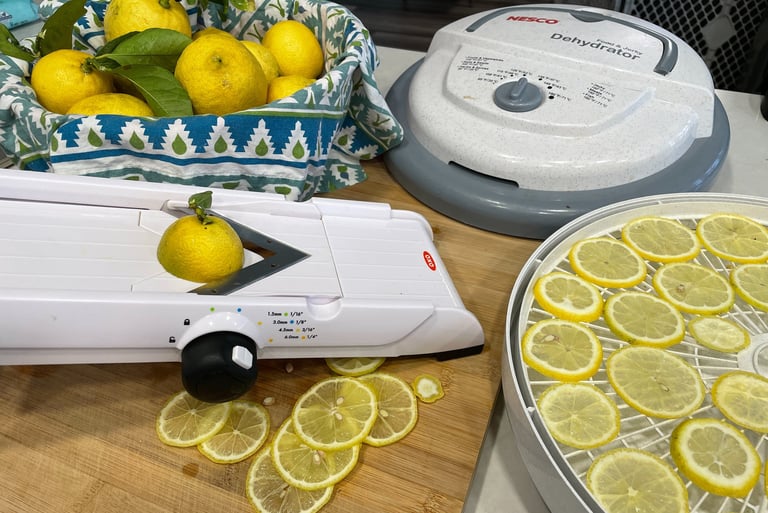How to Dehydrate Lemons: A Fast and Easy 6-Step Guide
Want to learn how to dehydrate lemons? This step-by-step guide breaks down how to slice and dehydrate citrus quickly and easily!
Want to learn how to dehydrate lemons and other citrus? It's a fairly easy process, made easier with this quick step by step guide. All you need are the right tools and a little bit of patience! And once you've gotten the hang of it, you'll be able to use your dehydrated lemons for gorgeous garnishes and lemon crafts - like garlands, gift tags, potpourri - the possibilities are endless!
But let's not get ahead of ourselves! We need to focus on the task at hand: dehydrating lemons! Follow along as I take you the easiest and quickest way to dehydrate lemons - a method I know well at this point! I've dehydrated well over 2,000lbs of citrus!!
2. Wash your lemons
Whether picked fresh from your tree or brought home from the grocery store, it's important to give your lemons and other citrus a bath.
For citrus shined with wax, you'll want to submerge your fruit in hot water to soften the wax, and then give a hefty scrub with a fruit brush.
Alternatively, you can use a fruit and veggie wash which will removes any dirt, wax and pesticides.
3. Slice the lemons thinly
In order to dehydrate lemons thoroughly and evenly, they should be sliced anywhere from 3/16" to 1/4"
I personally use a mandoline slicer, like this one. This V-Blade mandoline slicer is SHARP, quick and efficient. If using a mandoline, I'd also recommend using a protective glove (trust me, you'll be happy you did).
4. Place lemons on the dehydrator and dry
A dehydrator is an excellent option to dehydrate lemons evenly. Turn the heat to 135F-145F for around 6-12 hours (depending on thickness).
Halfway through your dry time, rotate your trays to ensure the lemons are dried as evenly as possible. Depending on how many trays you have stacked, you might find the lower trays are significantly less dry than the top trays at that halfway mark. Don't worry! It'll all work out in the end.
Out of the 4 dehydrators I own, I prefer the Nesco brand over any other. The heat distribution is the most even, and you can have up to 6 trays on one dehydrator at a time.
Lemons are notorious for turning brown while being dried. The fruit itself is consumable - nothing is wrong with it! If you're looking for the yellow aesthetic, you will need to check on them periodically to ensure they are taken out when they are just dry enough.
If you want the lemons to remain yellow, you can lower the temp down to 125F or 130F- your dry time will increase.
5. Remove the lemons when dry
I recommend taking a couple of lemon slices out of the dehydrator and letting them come to room temp before committing the entire batch. When they're crispy, turn off your dehydrator and immediately place in a Ziploc bag or airtight container.
Dehydrated lemons and other citrus/fruits are thirsty - they will absorb moisture out of the air in seconds. If you live in a particularly wet climate (rain/humidity), be sure to pay extra attention to sealing them up tightly. It's ok if they re-absorb moisture, but you want to make sure they do so on your terms.
6. Condition your lemons
This step is pertinent when you dehydrate lemons to ensure your fruit is shelf-stable.
For the next 5 days, you'll want to shake your ziploc, or other container to let your slices mingle with each other. If there's an imbalance in moisture, you will notice your lemons getting soft. If you do notice them get soggy, as long as there is no mold present, place them in your dehydrator again for a few hours. (If there is mold, it goes without saying the batch should be tossed)
Repeat this process as necessary.
A way to help prevent moisture imbalance, you really should rotate your trays. It's important to let the lemons come to room temperature first to really feel if they're done or not. It only takes moments and you'll be able to know immediately if you need to keep them in longer, or make that rotation.






1. Gather your lemons
The best time of year for lemons is the cooler months, particularly here in California. The trees are so overloaded - it's a gorgeous sight to see for sure! I'm lucky to have a lemon tree in my neighbor's yard so I can go out and pick as I need to. When citrus isn't growing locally, I find great deals on lemons at Costco Wholesale. Finally, checking out your neighborhood farmers market is a fun way to shop for citrus and meet your local growers.


Don't have a dehydrator?
That's OK! You can absolutely dehydrate lemons in your oven with a baking sheet. The biggest recommendation I have for this process is to use a cooling/cooking rack to get your lemons off of the baking sheet. Check out these racks, which you can stack into 3 tiers in the oven. More real estate means fewer batches!
To dehydrate lemons in the oven, follow the steps below
Gather your lemons
Wash the lemons
Slice the lemons thinly
Place lemons on cooking rack(s) and move your oven rack to the lowest level.
Turn your oven to the lowest temperature. Mine can only go to 170F at the lowest
Check on lemons after 2 hours and rotate or flip them if they're starting to dry.
Lemons done in the oven will dry much faster, but are also more likely to turn darker, faster.
Remove the lemons when dry
Condition the lemons
